Mohács
Mohács (Hungarian pronunciation: [ˈmohaːt͡ʃ]; Croatian and Bunjevac: Mohač; German: Mohatsch; Serbian: Мохач; Turkish: Mohaç) is a town in Baranya County, Hungary, on the right bank of the Danube.
Mohács
Mohač, Mohatsch | |
|---|---|
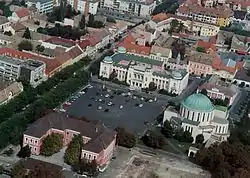 Aerial view | |
 Flag  Coat of arms | |
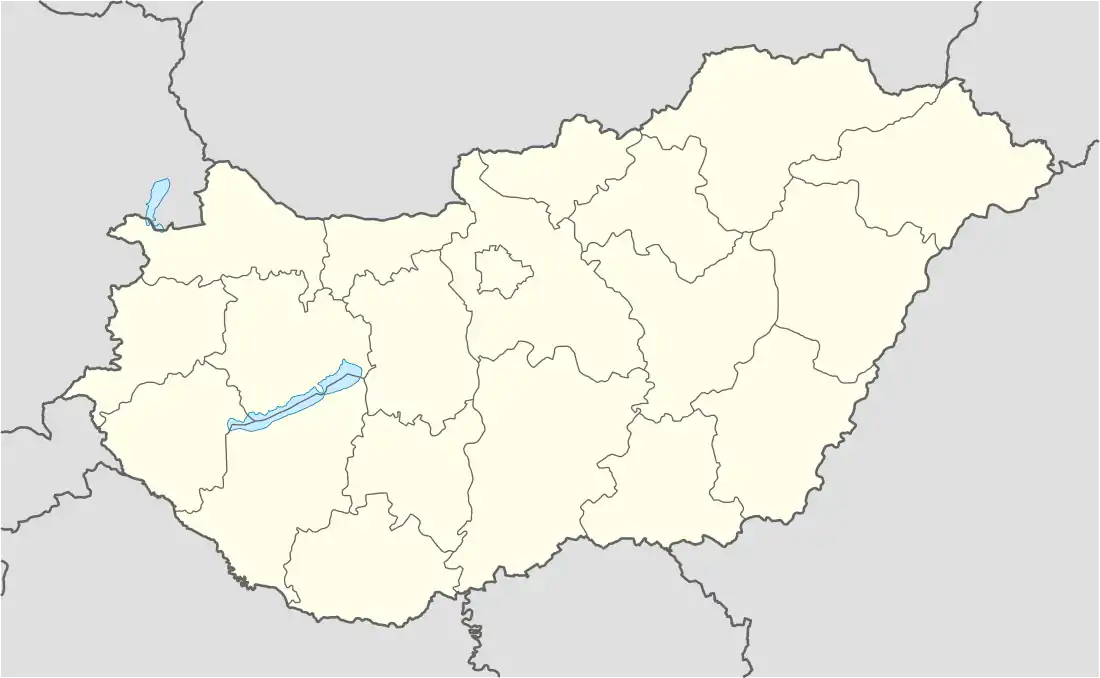 Mohács Location of Mohács | |
| Coordinates: 45.99593°N 18.67985°E | |
| Country | |
| County | Baranya |
| District | Mohács |
| Government | |
| • Mayor | Gábor Pávkovics (Fidesz) |
| Area | |
| • Total | 112.23 km2 (43.33 sq mi) |
| Population (2011) | |
| • Total | 17,808 |
| • Density | 158.67/km2 (411.0/sq mi) |
| Time zone | UTC+1 (CET) |
| • Summer (DST) | UTC+2 (CEST) |
| Postal code | 7700 |
| Area code | (+36) 69 |
| Website | www |
Etymology
The name probably comes from the Slavic *Mъchačь,*Mocháč: mъchъ (moss, Hungarian moha is a loanword from Slavic/) + the Slavic suffix -ačь, like Slovak Mochnáč or Czech Macháč.[1][2] See 1093/1190/1388 Mohach.[2]
History
Two famous battles took place in the vicinity of Mohács:
- Battle of Mohács, 1526
- Battle of Mohács, 1687
These battles represented the beginning and end, respectively, of the Ottoman domination of Hungary.
In Roman times there was a camp on the banks of the Danube near Mohács.
In the medieval Kingdom of Hungary, Mohács formed part of the historical Baranya county, and during Ottoman rule it functioned as the administrative seat of the Sanjak of Mohács, an Ottoman administrative unit.[3] After the Habsburgs took the area from the Ottomans, Mohács was included in the restored Baranya county.
In 1910 the population of the Mohács district numbered 56,909 people, of whom 21,951 spoke German, 20,699 Hungarian, 4,312 Serbian, and 421 Croatian. Another 9,600 inhabitants were listed as speaking "other languages".[4]
Until the end of World War II, Danube Swabians comprised the majority of the inhabitants - called locally Stifolder, because their ancestors came in the 17th and 18th centuries from Fulda (district).[5] Most of the former German settlers were expelled to Allied-occupied Germany and Allied-occupied Austria in 1945-1948, in accordance with the 1945 Potsdam Agreement.[6]
Events
Every spring, the town hosts the annual Busójárás carnival.
Demographics
According to the 2011 census, the total population of Mohács was 17,808, of whom there were 15,842 (84.2%) Hungarians, 1,723 (9.7%) Germans, 700 (3.9%) Croats, and 537 (3%) Romani. 14% of the total population did not declare their ethnicity. In Hungary, people can declare more than one ethnicity (dual identity), so the sum exceeds the total population.[7][8]
Twin towns – sister cities
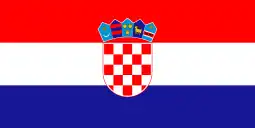 Beli Manastir, Croatia
Beli Manastir, Croatia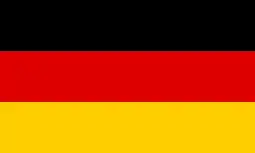 Bensheim, Germany
Bensheim, Germany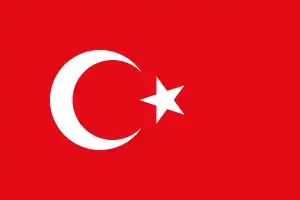 Beykoz, Turkey
Beykoz, Turkey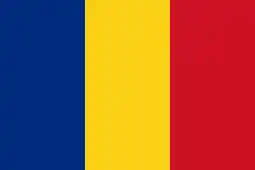 Câmpia Turzii, Romania
Câmpia Turzii, Romania Siemianowice Śląskie, Poland
Siemianowice Śląskie, Poland Sveti Filip i Jakov, Croatia
Sveti Filip i Jakov, Croatia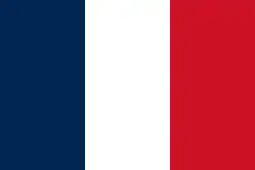 Wattrelos, France
Wattrelos, France
Notable citizens
- Ferenc Pfaff (1851–1913), Hungarian architect
- Endre Rozsda (1913–1919), Hungarian-French Painter
- Norbert Michelisz (1984), Hungarian racing driver
Sport
Mohácsi TE is the town's association football club.
Photos
 The Danube at Mohács
The Danube at Mohács Town Hall
Town Hall.JPG.webp) Church in the center of city
Church in the center of city Memorial park
Memorial park Memorial park
Memorial park%252C_2009.jpg.webp) Annual carnival Busójárás
Annual carnival Busójárás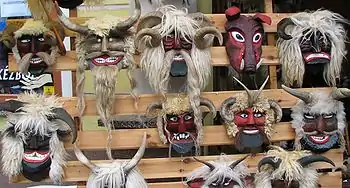 Buso masks
Buso masks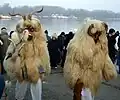 Carnival
Carnival Carnival
Carnival_-_city_limit.JPG.webp)
References
- This article incorporates text from a publication now in the public domain: Chisholm, Hugh, ed. (1911). "Mohács". Encyclopædia Britannica. Vol. 18 (11th ed.). Cambridge University Press. pp. 646–647.
- Stanislav, Ján (2004). Slovenský juh v stredoveku II (in Slovak). Slovenské literárne centrum. p. 298. ISBN 80-88878-89-6.
- Kiss, Lajos (1978). Földrajzi nevek etimológiai szótára (in Hungarian). Budapest: Akadémiai. p. 429.
-
Káldy-Nagy, Gyula, ed. (1985). A budai szandzsák 1546-1590: demográfiai és gazdaságtörténeti adatok. évi összeírásai. Volume 6 of Pest Megye múltjából, ISSN 0209-6013. Pest Megyei Levéltá. p. 32. ISBN 9789630161848. Retrieved 12 March 2022.
In the mid-16th century, the kile in the sanjak of Mohács was equal to the Hungarian fertál, which according to Turkish records, was the equivalent of 24 okkas (30.76 kg).
- "Baranya County". Archived from the original on 2008-03-29. Retrieved 2006-08-12.
- https://www.feked.hu/etc/Stifolder_tortenet.pdf.
- Die Vertreibung - "Die nahezu tausendjährige aufbauende Völkerfreundschaft wurde durch die Vertreibung eines Großteils der Ungarndeutschen nach dem zweiten Weltkrieg zerstört."
- Hungarian census 2011, Baranya County
- Hungarian census 2011 - final data and methodology
- "Nemzetközi kapcsolatok". mohács.hu (in Hungarian). Mohács. Retrieved 2021-03-24.
External links
- Official website in Hungarian, English and German

